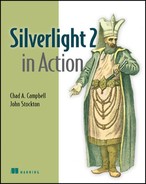List of Tables
Chapter 2. Harmony with the web
Table 2.1. The DOM variants supported by Silverlight
Table 2.2. The primary utility functions exposed through the Silverlight.js utility file
Table 2.3. The three approaches for referencing a Silverlight application
Table 2.4. The parameters of the onLoad event handler
Table 2.5. The properties associated with the errorArgs parameter
Table 2.6. The properties of the SilverlightHost object
Table 2.7. The entry points into the HtmlDocument
Table 2.8. The navigation methods of an HtmlDocument
Table 2.9. The navigation properties of an HtmlElement
Table 2.10. The prompt options available through the HtmlWindow class
Table 2.11. The navigation options available through the HtmlWindow class
Chapter 3. Back to the basics: Layout and text
Table 3.1. The word Welcome translated across several languages
Table 3.2. The font-related properties available in Silverlight and their CSS equivalents
Table 3.3. The acceptable values for the FontWeight property
Table 3.4. The acceptable values for the FontStretch property are listed under the Name column.
Chapter 4. Handling user interaction
Table 4.1. The properties of the KeyEventArgs class
Table 4.2. The ModifierKeys available within Silverlight 2
Table 4.3. The click-related events associated with the mouse
Table 4.4. The properties exposed by the MouseEventArgs
Table 4.5. The mouse-movement-related event handlers
Table 4.6. The options available within the ClickMode enumeration
Table 4.7. The flexibility of a ContentControl is displayed in these three buttons.
Table 4.8. The acceptable options for the TargetName property
Table 4.9. The CalendarMode options that can be used for the DisplayMode property
Table 4.10. The options available within the CalendarSelectionMode enumeration
Table 4.12. The properties associated with defining the range of a RangeBase instance
Table 4.13. The configuration properties available on the OpenFileDialog
Chapter 5. Getting down with data binding
Table 5.1. One example of a data template
Table 5.2. The types of columns that can be automatically generated within a DataGrid
Table 5.3. The options available through the DataGridHeadersVisibilityMode enumeration
Table 5.4. The options available through the DataGridHeadersVisibility enumeration
Table 5.5. A condensed list of operations available through LINQ
Chapter 6. Networking and communications
Table 6.1. Elements and attributes allowed in clientaccesspolicy.xml
Chapter 7. Managing digital media
Table 7.1. The major media formats supported by the MediaElement
Table 7.2. The options available within the MediaElementState enumeration
Table 7.3. The events of the MediaElement
Table 7.4. The ASX elements supported within Silverlight
Table 7.5. The SMIL elements supported within Silverlight
Table 7.6. The methods that control the progress of a MediaElement
Chapter 8. Getting a grip on graphics
Table 8.1. The Shape objects available within Silverlight.
Chapter 9. Bringing it to life: Animation
Table 9.1. Options for the Duration property
Table 9.2. The available FillBehavior options
Table 9.3. Methods associated with the Storyboard object
Table 9.4. The key frame types available within Silverlight 2
Chapter 10. Giving it style
Table 10.1. Several states of a Button. Each state has a slightly different visual appearance.
Chapter 11. Enhancing the experience
Table 11.1. Using the ? wildcard character in relation to figure 11.1
Table 11.2. The ways to open a file
Table 11.4. An example of how dynamic typing can be used
Table 11.5. Duck typing in action.
Table 11.7. Method signature comparison between C# and IronPython
Chapter 12. Share the light: Distribution and deployment
Table 12.1. Comparing a traditional property definition to a dependency property definition
Table 12.2. The properties of the DependencyPropertyChangedEventArgs structure
Table 12.3. The elements that can be used within the manifest.xml definition
Table 12.4. The file types accepted within a Silverlight Streaming application
